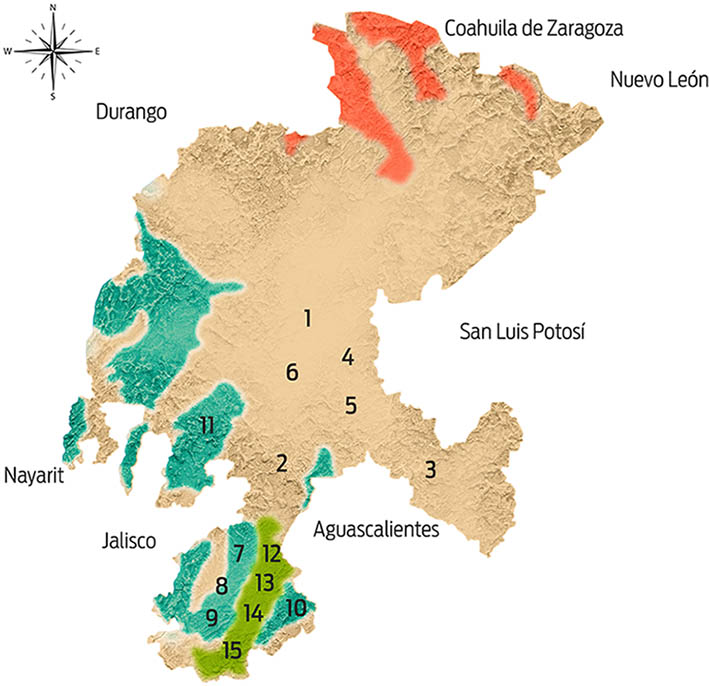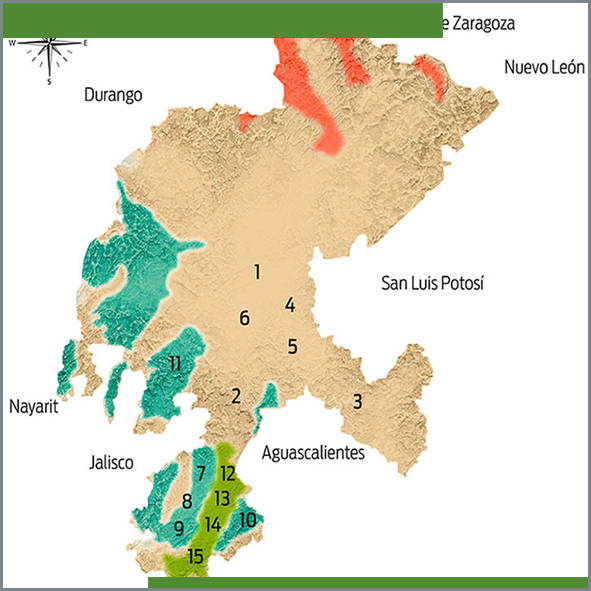Africanización de colonias de abejas melíferas (Apis mellifera) en tres zonas climáticas del estado de Zacatecas, México
Contenido principal del artículo
Resumen
Veterinaria México OA
ISSN: 2448-6760
Cómo citar este artículo:
- Medina Flores CA, Guzmán Novoa E, Hamiduzzaman MM, Aguilera Soto J, López Carlos MA. Africanización de colonias de abejas melíferas (Apis mellifera) en tres zonas climáticas del estado de Zacatecas, México. Veterinaria México OA. 2015;2(4). doi: 10.21753/vmoa.2.4.353
El presente trabajo fue realizado con el propósito de determinar la frecuencia de fenotipos y genotipos africanos y europeos en colonias manejadas de abejas melíferas de tres diferentes eco-ambientes del estado de Zacatecas. Se muestrearon 151 colonias de abejas distribuidas en 15 municipios del estado de Zacatecas, ubicados en tres diferentes zonas ecológicas; zona: 1) semiseca templada, 2) semiseca semicálida y 3) subhúmeda templada. Se determinó el tipo de ADNmt, mediante PCR-RFLP, así como el morfotipo por medio del sistema rápido de identificación de abejas africanizadas (FABIS, por sus siglas en inglés). Del total de colonias muestreadas en todas las zonas, los análisis de ADNmt mostraron mayor frecuencia de linaje materno europeo (77.5%) que de africano (22.5%; P<0.0001). Los análisis morfométricos, clasificaron al 42.4% de las colonias como africanizadas y al 47% como europeas (P<0.0001). La frecuencia de colonias con mitotipo y morfotipo africano y europeo varió significativamente (P<0.05) en cada zona y sugieren un mayor grado de africanización en la zona semiseca semicálida, la mayor frecuencia de colonias con mitotipo y morfotipo europeo se presentó en la zona semiseca templada. Los resultados muestran que el clima y ambiente afectan el grado de africanización de las colonias de abejas en el Norte de México y que es posible que la africanización haya llegado a un punto de equilibrio. Las colonias establecidas en zonas de mayor altitud y con climas más templados mantendrán genotipos de abejas más europeos que africanos, mientras que lo contrario se espera en las zonas más tropicales.

Detalles del artículo
Citas
Clarke KE, Rinderer TE, Franck P, Quezada-Euán JJG, Oldroyd BP. 2002. The Africanization of honey bees (Apis mellifera L.) of the Yucatan: a study of a massive hybridization event across time. Evolution, 56(7):1462-1474. DOI: 10.1111/j.0014-3820.2002.tb01458.x
Danka RG, Hellmich RL, Rinderer TE. 1992. Nest usurpation, supersedure and colony failure contribute to Africanization of commercially managed European honey bees in Venezuela. Journal of Apicultural Research, 31(3-4):119-123.
Domínguez-Ayala R, Moo-Valle H, May-Itzá WDJ, Medina-Peralta S, Quezada-Euán JJG. 2015. Stock composition of northern neotropical honey bees: mitotype and morphotype diversity in Mexico (Hymenoptera: Apidae). Apidologie, 1-11. DOI: 10.1007/s13592-015-0414-6
Guzmán-Novoa E, Uribe RJL. 2004. Honey production by european, africanized and hybrid honey bee (Apis mellifera) colonies in Mexico. American Bee Journal, 144:318-320.
Guzmán-Novoa E, Correa-Benítez A, Guzmán G, Espinosa LG. 2011. History, colonization and impact of the africanized honey bee in Mexico. Veterinaria México, 42(2):149-178.
Hall GH. 1992. DNA studies reveal processes involved in the spread of New World African Honeybees. Florida Entomologist, 75(1):51-59. DOI:10.2307/3495480
[INEGI] Instituto Nacional de Estadística Geografía e Informática. 2005. Municipios de Zacatecas, pp. 234-235.
Kerr WE. 1967. The history of the introduction of African bees to Brazil. South African Bee Journal, 39:3-5.
Nielsen DI, Ebert PR, Page RE Jr, Hunt GJ, Guzmán-Novoa E. 2000. Improved polymerase chain reaction-based mitochondrial genotype assay for identification of the africanized honey bee (Hymenoptera: Apidae). Annals of the Entomological Society of America, 93(1):1-6.
Nogueira-Neto P. 1964. The spread of a fierce African bee in Brazil. Bee World, 45(3):119-121.
Otis GW. 1991. Population biology of the africanized honey bee. In: Spivak M, Fletcher D, Breed M. The African Honey Bee. Boulder, Colorado, USA: Westview Press, pp. 213-234.
Pinto AM, Rubink WL, Patton JC, Coulson RN, Johnston JS. 2005. Africanization in the United States: replacement of feral european honey bees (Apis mellifera L.) by an african hybrid swarm. Genetics, 170:1653-1665.
Quezada-Euán JJG. 2000. Hybridization between european and africanized honeybees in tropical Yucatan, Mexico. II. Morphometric, allozymic and mitochondrial DNA variability in feral colonies. Apidologie, 31(3):443-454. DOI:10.1051/apido:2003010
Quezada-Euán JJG. 2007. A retrospective history of the expansion of africanized honeybees in México. Journal of Apicultural Research and Bee World, 46(4):295-300. DOI: 10.1080/00218839.2007.11101412
Quezada-Euán JJG, Medina LM. 1998. Hybridization between european and africanized honeybees (Apis mellifera L.) in tropical Yucatan, Mexico. I. Morphometric changes in feral and managed colonies. Apidologie, 29(6):555-568
Rinderer TE, Hellmich RL. 1991. The processes of africanization. In: Spivak M, Fletcher D, Breed M. The African Honey Bee. Boulder, Colorado, USA: Westview Press, pp. 373-398.
Rinderer TE, Oldroyd BP, Sheppard WS. 1993. Africanized bees in the U.S. Scientific American, 269:52-58.
[SAGARPA] Secretaría de Agricultura, Ganadería, Desarrollo Rural, Pesca y Alimentación. Servicio de información y estadística agroalimentaria (SIAP). 2005. http://www.siap.sagarpa.gob.mx [access: 14 jul 2011].
SAS Institute. 2002. Statistical software Ver. 9.0. [en línea] Cary, North Carolina, USA.
Schneider SS, DeGrandi-Hoffman G, Smith DR. 2004. The african honey bee: factors contributing to a successful biological invasion. Annual Review Entomology, 49(1):351-376. DOI: 10.1146/annurev.ento.49.061802.123359
Smith DR. 1991. African bees in the Americas: insights from biogeography and genetics. Trends in Ecology and Evolution, 6(1):17-21.
Sylvester HA, Rinderer TE. 1987. Fast Africanized Bee Identification System (FABIS) Manual. American Bee Journal, 127(7):511-516.
Taylor OR. 1977. The past and possible future spread of africanized honey bees in the Americas. Bee World, 58:19-30.
Uribe RJL, Guzmán-Novoa E, Hunt GJ, Correa BA, Zozaya RJA. 2003. Efecto de la africanización sobre la producción de miel, comportamiento defensivo y tamaño de las abejas melíferas (Apis mellifera L.) en el altiplano mexicano. Veterinaria México, 34(1):47-59.
Whitfield CW, Behura SK, Berlocher SH, Clark AG, Johnston JS, Sheppard WS, Smith DR, Suarez AV, Weaver D, Tsutsui ND. 2006. Thrice out of Africa: ancient and recent expansions of the honey bee, Apis mellifera. Science, 314(5799):642-645.
Zamora O, Domínguez R, Alaníz-Gutiérrez L, Quezada-Euán JJG. 2008. Frequency of european and african-derived morphotypes and haplotypes in colonies of honey bees (Apis mellifera) from NW México. Apidologie, 39(4):388-396. DOI: 10.1051/apido:2008016
License

Veterinaria México OA por Facultad de Medicina Veterinaria y Zootecnia de la Universidad Nacional Autónoma de México se distribuye bajo una Licencia Creative Commons Atribución 4.0 Internacional.
Basada en una obra en http://www.revistas.unam.mx
- Todos los artículos en Veterinaria México OA se publican bajo una licencia de Creative Commons Reconocimiento 4.0 Unported (CC-BY 4.0). Con esta licencia, los autores retienen el derecho de autor, pero permiten a cualquier usuario compartir, copiar, distribuir, transmitir, adaptar y hacer uso comercial de la obra sin necesidad de proporcionar un permiso adicional, siempre y cuando se otorgue el debido reconocimiento al autor o fuente original.
- Al utilizar esta licencia, los artículos en Veterinaria México OA cubren o exceden todos los requisitos fundacionales e institucionales para ser considerados de Acceso Abierto.
- Los autores no pueden utilizar material protegido por derechos de autor en su artículo a menos que ese material esté también disponible bajo una licencia igualmente generosa.



